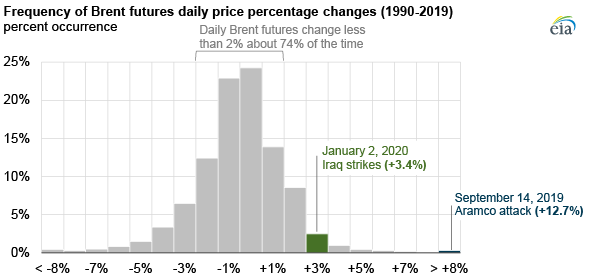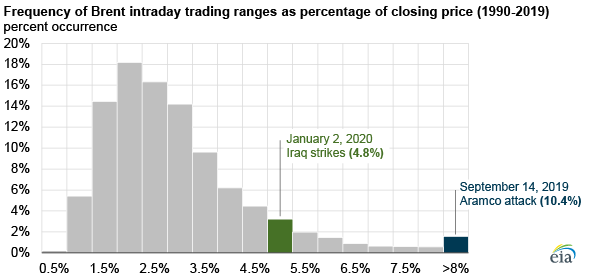Risk of oil supply disruptions can have an immediate effect on oil prices
Jan 31, 2020
Crude oil supply disruptions—realized or expected—can have large and immediate effects on crude oil prices. Two recent events, the September 2019 attacks on Saudi Aramco facilities at Abqaiq and Khurais (which disrupted crude oil volumes) and the January 2020 military operations in Iraq (which did not disrupt crude oil volumes), led to relatively large daily price changes and intraday price movements—movements within single trading days. Intraday prices of front-month Brent crude oil futures for the two events followed a broadly similar path at first: an upward movement as market participants reacted to the news and a downward movement as new information was incorporated.
In the case of the September attacks on Saudi Aramco, the initial price increase was delayed because the event took place over the weekend when the Intercontinental Exchange (ICE)—the exchange on which Brent futures are traded—was closed. Consequently, when Brent futures resumed trading, market participants had already had two days to react to the news. Brent crude oil prices opened at $71.57 per barrel (b) at 6:00 p.m. Eastern Standard Time (EST) on September 15, 2019, before falling to $67.00/b within 23 minutes of trading and $65.09/b after a further nine hours of trading.
Prices following the January 2020 military action in Iraq initially played out similarly: an early large upward movement followed by an eventual downward reversion. But unlike the Aramco attacks, Brent was actively traded while the military operation occurred. Although the precise timing of the January U.S. military operation in Iraq varies by report, it took somewhere between three to five hours for the market to react, reaching $67.44/b by 9:00 p.m. EST.
The nature of these two events were different. The attacks on Aramco took physical barrels of oil off the markets. According to Aramco, the attacks on Khurais shuttered the 1.2 million barrel per day (b/d) field for 24 hours. Crude oil processing at the Abqaiq facility was reduced to just 2.0 million b/d on September 17, a small fraction of its estimated capacity of about 7.0 million b/d. The January U.S. military operation in Iraq, however, did not directly affect physical barrels in production, storage, or transit, but it did affect the perceived risk that future barrels could be affected.

The magnitude of the price changes following these attacks was relatively large and rare. For the past 29 years, daily Brent crude oil prices changed by less than 2% relative to the previous trading day 74% of the time. The 3.4% change on January 2 following the U.S. military operation in Iraq was larger than 95% of the daily price percentage changes in the past 29 years, and the 12.7% change following the Aramco attacks was the largest daily price percentage change in the past 29 years.
The intraday trading range (the difference between a day’s highest and lowest prices, expressed as a percentage of the closing price) was also relatively large during the two events. From 1990 through 2019, about two-thirds of all trading days had an intraday range smaller than 3% of the closing price. However, the intraday ranges for September 14, 2019, and January 2, 2020, were 10.4% and 4.8%, respectively, of each day’s closing price.

Similar Stories

LNG powers unprecedented year for orders of alternative-fueled vessels
View Article
Since the 2011 Fukushima accident, Japan has restarted 14 nuclear reactors
View Article
Shell starts production at Whale in the US Gulf of Mexico
View Article
European gas prices fall despite Norwegian outage - Rystad Energy’s Gas and LNG Market Update
View ArticleHycamite is getting ready for the next growth steps
A successful investment round completed with long-term equity commitments of high-quality investors
View Article
Alleima supplies Preem in the green transition of the aviation industry
View ArticleGet the most up-to-date trending news!
SubscribeIndustry updates and weekly newsletter direct to your inbox!





